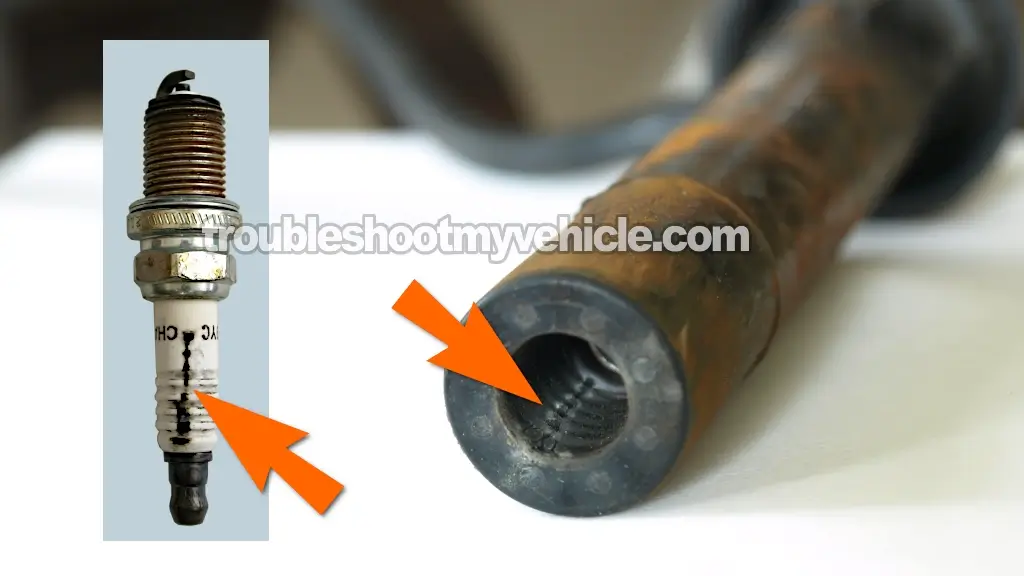TEST 6: Activation Signal For Cylinders 2 And 3

In this test section, we're gonna check that the ignition coil (within the coil pack) that fires spark to cylinders 2 and 3 is receiving its activation signal from the PCM.
The wire that delivers this 'cylinders 2 and 3 activation signal' to the ignition coil is the blue with brown stripe (BLU/BRN) wire of the ignition coil's 3-wire connector.
This BLU/BRN wire connects to the female terminal of the connector I've labeled with the number 1 in the illustration above.
NOTE: I strongly advice against using a regular 12 Volt test light to test for the presence of the IC activation signal. The safest way (that won't damage the PCM) to check for the presence of the activation signal is with an LED light.
CAUTION: The terminals of the LED need to be inserted into the female terminals of the ignition coil's connector. The LED light's terminals cannot be thicker than the ignition coil's male spade terminals that mate into the connector's female terminals. You may need to modify the terminals of the LED light so that they match the width and thickness of the ignition coil's male spade terminals, to avoid damaging them.
Let's begin:
- 1
Disconnect the ignition coil from its 3-wire electrical connector.
- 2
Connect the red lead of the LED light to terminal number 2.
Terminal number 2 is the terminal that supplies power to the ignition coil. - 3
Connect the black lead of the LED light to the terminal identified with the number 1 (see illustration above).
Terminal 1 should connect to the blue with brown stripe (BLU/BRN) wire of the ignition coil's 3-wire connector. - 4
Have your helper crank the engine.
- 5
The LED light should flash ON and OFF the whole time the engine is cranking.
Let's find out what your test result means:
CASE 1: The LED light flashed ON and OFF the whole time the engine was cranking or running. This is the correct test result and it means that the PCM is providing the activation signal and the circuit is OK.
You can conclude that the ignition coil pack is bad if you have:
- Confirmed that the spark plug wires for cylinders 2 and 3 are not sparking (TEST 1).
- Confirmed that the ignition coil towers for cylinders 2 and 3 are not sparking (TEST 3).
- Confirmed that the ignition coil pack is receiving the 2/3 activation signal from the fuel injection computer in this test section.
CASE 2: The LED light DID NOT flash ON and OFF the whole time the engine was cranking or running. This usually means that there's either an open-circuit problem in the wire between the connector and the PCM or the PCM is fried (altho a bad PCM is rare).
With this result you have eliminated the coil pack itself as the source of the misfire condition or no-spark condition.
Other Things That Can Cause A Misfire

Quite a few other things, besides a bad ignition coil, can cause the engine in your Ford Fiesta to misfire. If all of your test indicate the ignition coil is not causing the misfire issue, here are a couple of suggestions that might help:
- Inspect the inside of the spark plug wire boots and the ceramic insulator of the spark plug for carbon tracks
- The the orange arrows in the photo above point to what carbon tracks look like.
- Replace the components as affected with carbon tracks.
- Engine compression test.
- One of the most overlooked diagnostic tests to find the root cause of misfire is the compression test.
- You'll need an engine compression tester of course.
- The engine between cylinders should not vary more 15%.
- How To Test Engine Compression (2011-2019 1.6L Ford Fiesta).
- Fuel injector test.
- There are several methods to test them which are beyond the scope of this article, but the fastest way to test them is by checking the resistance (Ohms) value of each one and comparing them to each other.
- Any resistance that's not within the average of the others indicates the fuel injector is fried.
- How To Test The Fuel Injectors (2011-2019 1.6L Ford Fiesta).
- You can buy a specific fuel injector tester online that activates by a predetermined pulse width and measuring the fuel pressure drop on a fuel pressure gauge.

If this info saved the day, buy me a beer!


